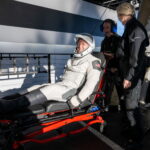
NASA’s James Webb Space Telescope recently detected a planet that could possibly sustain life based on temperature readings, which has a mass approximately 100 times the size of Earth.
The planet, which astronomers believe is orbiting a young red dwarf star approximately 34 light years away, has been dubbed TWA 7b and is roughly the size of Saturn.
An initial analysis suggests the planet has a temperature of near 120 degrees Fahrenheit, which is warm enough to support life. Scientists believe life can grow and reproduce starting at about 5 degrees Fahrenheit and as high as 251 degrees Fahrenheit, per ABC News.
“Our observations reveal a strong candidate for a planet shaping the structure of the TWA 7 debris disk, and its position is exactly where we expected to find a planet of this mass,” lead researcher Anne-Marie Lagrange said in a statement.
Click this link for the original source of this article.
Author: Faith Novak
This content is courtesy of, and owned and copyrighted by, https://www.offthepress.com and its author. This content is made available by use of the public RSS feed offered by the host site and is used for educational purposes only. If you are the author or represent the host site and would like this content removed now and in the future, please contact USSANews.com using the email address in the Contact page found in the website menu.







